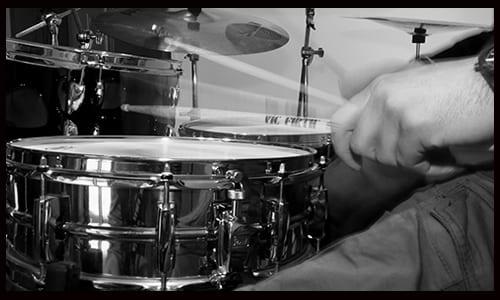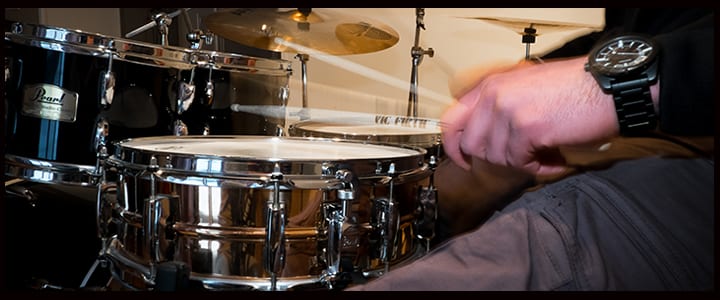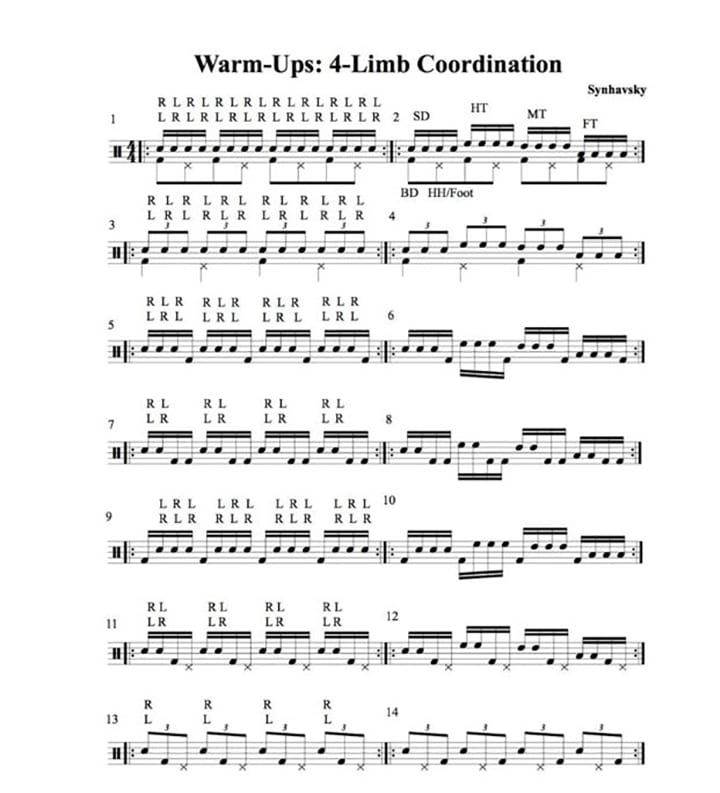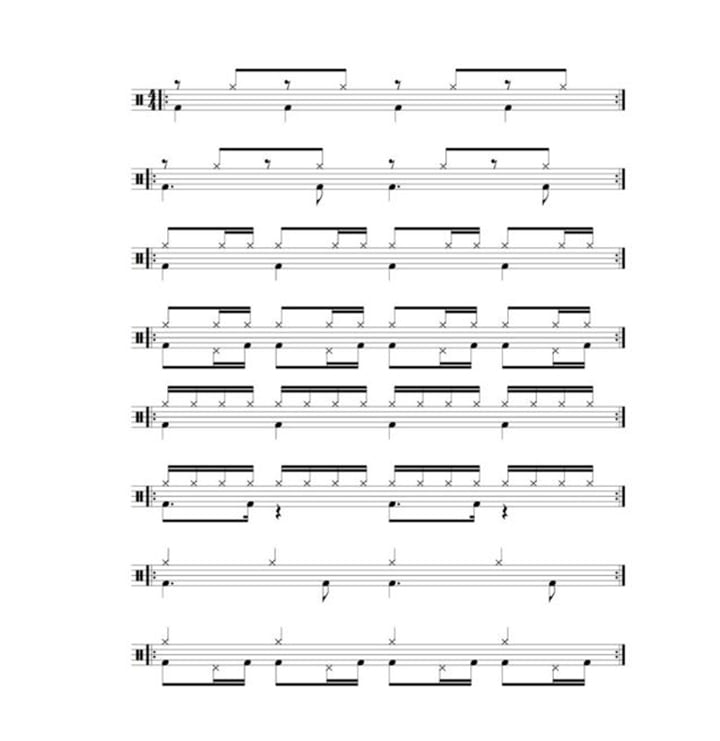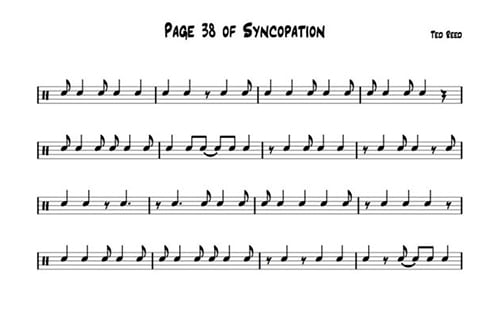If you want to improve as a drummer, you have to practice! But how can you make your practice time more productive? By working on specific drum exercises, you can strengthen your weaknesses and work on important aspects of drumming that will improve your technique.
You’ll find below a collection of rhythmic patterns that develop your drumming coordination and independence. In this article, we’re going to take a look at a wide range of exercises that are fantastic for beginner drummers and even the most advanced players. Ready to improve your drum skills? Grab your drum sticks and let’s go!
What Are the Best Drum Exercises to Use?
The best drum exercises are those that help you improve your technique. Like any instrument, there are different exercises to use for building different skills. Drummers practice exercises on drum pads, the snare drum, or the entire drum set. These exercises are designed to improve your timekeeping and rhythm, as well as speed, limb independence, and stamina.
See also: How to Play Drums: The Complete Guide for Beginners
Drum Warm Ups
Drumming is a physical activity, and like most physical activities, it’s important to warm up your muscles and get your limbs working in coordination. Whether preparing to practice in the woodshed or perform on stage, I always try to incorporate at least 5 to 15 minutes of drum warm ups into my routine.
Warm-ups can range in difficulty, but it’s important to pick exercises that are appropriate for your skill level, because these exercises are geared toward simple coordination and building your confidence behind the drum set. That being said, I encourage drummers to use a metronome when warming up because it strengthens your time-keeping in addition to warming up your body.
For Drum Pad
First, let’s take a look at a few simple drum warm ups, called rudiments. Drum rudiments are drum patterns that you can use for drills or warm ups, or develop into more complex drum patterns.
These exercises are designed to be played on one surface, and I like to play them on a drum pad before hitting the stage for a performance.
1. Single Stroke Roll
The single stroke roll is the most basic rudiment. Yet, it is also one of the most difficult to master. This roll alternates between the hands in a “right” to “left” or “left” to “right” manner. You may begin with either hand. It’s important to keep the rhythm steady and even. You might begin with eighth notes, and then try playing faster rhythms such as sixteenth or thirty-second notes.
Often, drummers practice rolls slowly, and then gradually increase the tempo using an accelerando (gradual speed-up). While this is an accepted method of practice, it may be more practical to use a metronome to work on rhythmical precision and timing. When playing this roll at ultrafast speeds, you may rotate your hands in an “upward thumb position” and use a cupping motion with your middle, ring, and pinky fingers.
2. Double Stroke Roll
The double stroke roll is the granddaddy of all the rudiments. Often referred to as the long roll, the double stroke uses a “right, right, left, left” sticking pattern. This sticking may be reversed so that you lead with the left hand. The first note of the double stroke pair is called the “primary stroke,” and the second note is called the “secondary stroke.” The secondary stroke must be bounced in order to play this rudiment fast.
3. Single Paraddidle
The single paradiddle is a combination of the single stroke roll and the double stroke roll. The sticking is: “right, left, right, right” then “left, right, left, left.” The “right, left” is the single stroke roll component, and the “right, right” is the double stroke roll component. (The same is true when the sticking is reversed and you lead with the left hand.) The single paradiddle is one of the most effective and versatile rudiments in all styles of music and drumming.
4. Double Paraddidle
The double paradiddle is very similar to the single paradiddle. The only difference is that another pair of single strokes is added to the sticking pattern. For example, instead of “right, left, right, right” used to play the single paradiddle, the double paradiddle sticking is: “right, left, right, left, right, right.” This is also played in reverse, leading with the left hand.
5. Triplets (Single Stroke Seven)
The single stroke seven is a relatively new drum rudiment introduced by the Percussive Arts Society. It is a short, 7-stroke single stroke roll played as sextuplets or sixteenth note triplets. Its application may be broad, but it is most commonly used in drum corp and marching band music.
6. Flam-Tap
The flam-tap is one of 11 flam rudiments. Before you try the flam-tap, you should make sure you can play alternating flams. Flam rudiments use “control strokes,” which determine stick height.
The flam contains 1.) a main note, which is a counted rhythm, and 2.) a grace note, which appears before the main note. The grace note is written “cue size” (smaller) and is never counted; it is merely an embellishment. The drummer plays the grace note with the tip of the stick positioned about an inch above the drum pad, while the stick used to play the main note is pointed either fully upright or at a 45 degree angle. When playing a flam tap, the drummer will add an additional tap stroke. This tap is played with the stick that was used to strike the main note. The flam tap is essentially a slow double stroke roll with flams added.
Wondering more about how these rudiments are played? Or looking to try them out yourself? Pull out your drum sticks and follow along with this helpful video below.
Want to Know More About Drum Rudiments?
To find out more about drum rudiments, follow along with this helpful video:
For Beginners
Now, let’s try some drum warm ups that incorporate the whole drum set. These warm ups are more challenging than the drum pad warm-ups because they incorporate more drums and the coordination of all four limbs.
Start slow, and remember: it’s about accuracy and coordination, not speed and power. If these exercises seem difficult, try subtracting one limb (I usually recommend the hi-hat foot), and then try the exercises with just three limbs.
Note: These exercises are divided into groups of two. The exercises on the left use just one surface for the hands (snare drum), while the exercises on the right focus on moving the hands around the drum kit.
Make sure to practice leading with both the right and left hand, and don’t forget to use a metronome!
For Snare
Snare drum independence refers to the ability to play snare drum rhythms that are separate from the pattern(s) performed by the rest of your limbs.
For beginning drummers, I recommend playing the exercises on the left, which focus on just two voices on the drum set (snare drum and hi-hat). Intermediate drummers may benefit from playing the exercises on the right, which incorporate a steady bass drum pattern in addition to the hands.
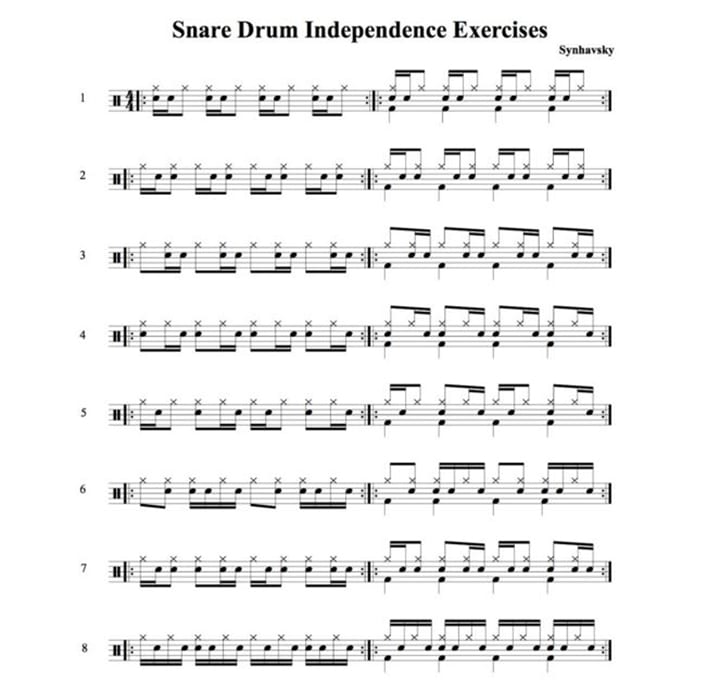
If you’re more advanced, try playing the snare patterns over more challenging rhythmic patterns.
Here are a few examples of trickier bass drum and hi-hat patterns which can be played along with the snare drum patterns from the sheet above:
The goal of all these drum exercises is to be able to apply any number of snare drum rhythms freely to your own drumming, rather than just playing a repetitive loop. Try mixing and matching the various exercises to come up with your own snare drum melody, or make up your own snare drum rhythms!
For Bass Drum
Bass drum independence refers to the ability to play bass drum rhythms that are separate from the pattern(s) performed by the rest of your limbs. Much like the snare drum independence exercises, I recommend that beginners focus on just two voices on the drum set (bass drum and hi-hat) before adding the third (snare drum).
Check out this video from Online Drummer and accompanying sheet music (below) for a series of great bass drum independence exercises.
For Increasing Speed
Besides how to improve, most beginner drummers want to know how to play drums faster. Like the other skills we’ve discussed (coordination and independence), becoming a faster drummer doesn’t just happen overnight. Let’s take a look at several drum exercises to help improve your speed.
For Develop Sound Technique
While there are a number of correct drum techniques, there are an awful lot more incorrect techniques that will inhibit your speed. Poor technique can even potentially cause injury, in the long run.
Developing good drumstick technique takes time and lots of practice. As a beginner, it’s important to watch your hands to make sure you’re using proper stick technique. Check out this video to learn a few simple drum exercises that will increase your hand speed.
There are a number of things you can try to boost your drum technique. For example, play heel down vs. heel up, or bury the beater against the head vs. releasing the beater from the head.
I also recommend playing along with the simple exercises in this video from Drumeo to improve your bass drum speed.
For Improving Stamina
When you practice drumming, use sticks that are heavier than your regular drum sticks. In much the same way that baseball players put weights on their bats before going up to bat, practicing with heavier drum sticks will make your usual sticks seem almost effortless when you switch back.
Practice single strokes, double strokes, and paradiddles with a metronome, gradually increasing your metronome speed. Then practice alternating singles, doubles, and paradiddles between the hands and feet. The four-limb drumming warm up exercises in this article are also great to develop speed. Remember, speed comes from both of your hands being even, so make sure you practice leading with both.
For Developing Independence
These drum warm ups are just the tip of the iceberg when it comes to getting ready to play and developing independence with each limb. Most of the exercises focus on straight rhythmic patterns, but I encourage drummers to try the exercises with a triplet-based, “swing” feel.
Here is a video that can help beginner drummers learn to swing a drum pattern:
For more rhythmic drum exercises, I recommend purchasing Ted Reed’s book Progressive Steps to Syncopation for the Modern Drummer. This book is often considered the most important source for developing independence, as it provides page after page of unique rhythms that can be applied to any limb on the drum set, and performed either swung or straight.
Below is a brief excerpt from his book that combines a wide range of patterns into an exercise that will test overall independence of any limb you choose. These rhythms can be translated to any drum(s) and can be played with either a straight or swing feel.
Which of These Drum Exercises Do You Find Most Useful?
Now you have several different drum exercises to keep you busy and help you improve! If you need help with any of these exercises, make sure to ask your drum teacher!
Which of these have you tried? What did you think? Let us know in the comments below!
 Post Author: John S.
Post Author: John S.John S. is a drum and percussion instructor in Saint Paul, MN. A full-time musician and teacher, he performs with two different bands and teaches in-home and in-studio lessons. Learn more about John here!
Photo Courtesy: David Russo
Maile Proctor
